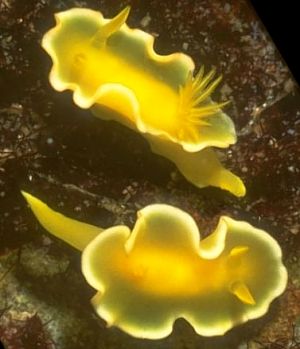
Noumea crocea
Rudman, 1986
Order: NUDIBRANCHIA
Suborder: DORIDINA
Family: Chromodorididae
DISTRIBUTION
Western Pacific - Known from Queensland and Solomon Islands. [Also messages in Forum from Indonesia, Philippines, Marshall Ids]
PHOTO
Moreton Bay, Queensland, 16mm long. Photo: Richard Willan.
RELATED TOPIC
The whole of the body, including the gills and the rhinophores, is yellow except for a pale almost white band around the mantle margin. At the extreme edge of the mantle outside the white band is a thin yellow line. The mantle is ovate with a moderately wide mantle skirt which has a semi-permanent fold half way along each side and also some temporary folding. The simple gills are arranged in a circle, open posteriorly, around the anus. From the preserved specimens, the mantle glands appear to be small single glands arranged in a multiple band around the mantle edge. As in Noumea flava, the mantle fold halfway along each side is more characteristic of Thorunna than Noumea but the buccal armature and reproductive system, both very similar to those of N. flava, clearly place this species in the genus Noumea.
Reference:
• Rudman, W.B. (1986) The Chromodorididae (Opisthobranchia: Mollusca) of the Indo-West Pacific: Noumea flava colour group. Zoological Journal of the Linnean Society, 88: 377-404.
Rudman, W.B., 1998 (March 28) Noumea crocea Rudman, 1986. [In] Sea Slug Forum. Australian Museum, Sydney. Available from http://www.seaslugforum.net/find/noucroc
Related messages
Noumea crocea from the Philippines
June 24, 2006
From: Carlos R. Munda
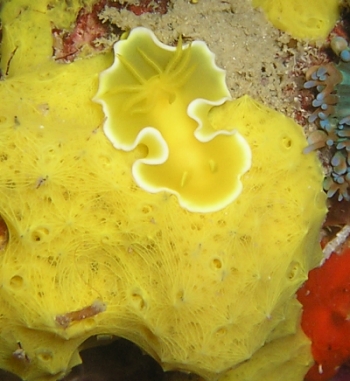
Could anyone tell me what kind of Glossodoris this is. it looks like G. electra but in reverse.
Locality: Penaplata, Samal island, 20-30 feet, Davao gulf, Philippines, Pacific, march 2006, shallow reef near beach. Length: 1/2 inch. Photographer: Carlos R. Munda, jr..
thanks
Carlos R. Munda
c_munda@yahoo.com
Munda, C.R., 2006 (Jun 24) Noumea crocea from the Philippines. [Message in] Sea Slug Forum. Australian Museum, Sydney. Available from http://www.seaslugforum.net/find/16958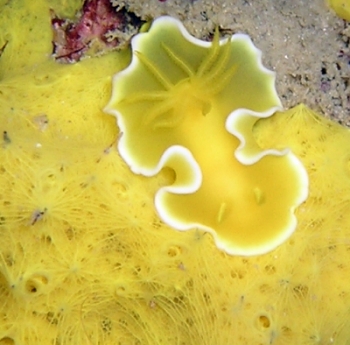
Dear Carlos,
This is Noumea crocea, one of a number of yellow species of chromodorid[see N. flava colour group], which are very well camouflaged on their food sponges. If you look at the other messages on this species you will see we have two other records of N. crocea on this bright yellow species of Darwinella. It is good to get further confirmation that this is its preferred food.
Best wishes,
Bill Rudman
Noumea crocea from sthn Queensland, Australia
February 15, 2006
From: Bruce Wilkie
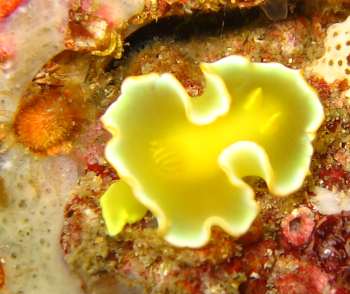
Hi Bill,
I was reading your reply to Craig Beasley [#15697 ] and your general comment about multiple species in one post. As my last post contained 3 unknowns, I will send you the 3 unknowns again but this time individually.
(being new to this forum, I am still finding my way around.)
Also thanks for the correct spelling for C. elisabethina. In one of the books I have it is spelt with a "z".
Locality: Manta Bommie Point Lookout North Stradbroke Island, 8 metres, Queensland Australia, Pacific ocean, 7 January 2006, rocky reef with sponges, hard & soft corals. Length: 20 mm. Photographer: Bruce Wilkie
I have since identified this little fella as Noumea crocea. Could you please confirm?
Many Thanks,
Bruce Wilkie.
brucedwilkie@yahoo.com.au
Wilkie, B., 2006 (Feb 15) Noumea crocea from sthn Queensland, Australia. [Message in] Sea Slug Forum. Australian Museum, Sydney. Available from http://www.seaslugforum.net/find/15791Dear Bruce,
Thanks for splitting your message up. In the early days of the Forum when messages weren't so frequent I wasn't so pressed for time, but now I am desperate for any help I can get from those sending messages to make the 'editing' part of my task as easy as possible.
Yes this is Noumea crocea.
Best wishes,
Bill Rudman
Noumea crocea from Indonesia
September 19, 2005
From: Bob Widman
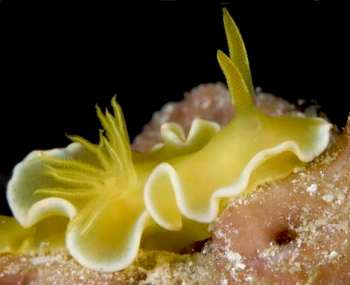
I found this nudibranch in Indonesia (Wakatobi) while diving along a wall on Sept. 10, 2005. The nearest nudibranch I found is one you call Glossodoris sp. 13. Any ideas?
Locality: Wakatobi, Indonesia.Depth: 60 ft.Length: 1/2 inch.10 September 2005. Photographer: Bob Widman
Bob
bob@seashots.com
Widman, R., 2005 (Sep 19) Noumea crocea from Indonesia. [Message in] Sea Slug Forum. Australian Museum, Sydney. Available from http://www.seaslugforum.net/find/14791Dear Bob,
This is Noumea crocea.
Best wishes,
Bill Rudman
Feeding in Noumea crocea
July 19, 2005
From: Erwin Koehler
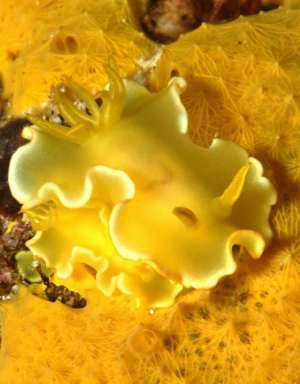
Dear Bill,
Here is a shot of 2 Noumea crocea feeding on a sponge, the same as in Scott Johnson's message #4599. Do you have a name for this sponge?
Locality: Nunez Shoal, Malapascua Is., Philippines. Depth: 9 m. Length: 16 + 23 mm. 10 March 2005. Photographer: Erwin Koehler
Regards Erwin
www.Philippine-Sea-Slugs.com
Erwin@Philippine-Sea-Slugs.com
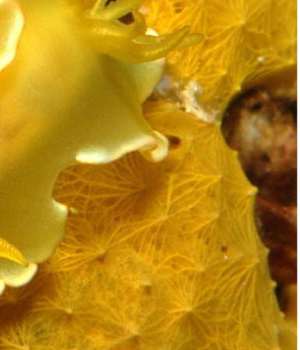
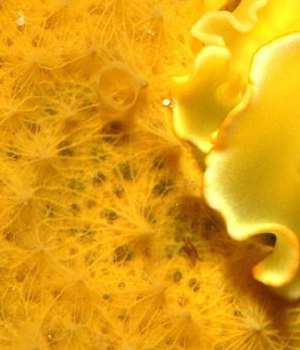
Dear Erwin,
Thanks for this photo which is a useful confirmation on the diet of this species. From the very characteristic structure of the colony it is a species of Darwinella, but like many nudibranch groups it is a 'sp' at this stage. I hope to complete this month, with Dr P.R. Bergquist, a manuscript on the sponge diets of the chromodorids, which shows some very interesting patterns. Forum contributions, like yours, have been an invaluable source of information.
Best wishes,
Bill Rudman
Record of Noumea crocea from the Philippines
June 2, 2002
From: Fredy Brauchli
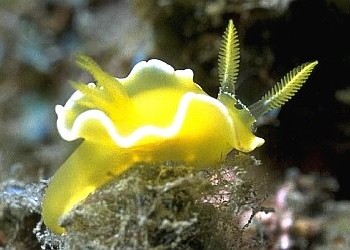
Hello Bill
Noumea crocea is well known from the Papua New Guinea region. I am happy to present you a record from the northern part of the Philippines.
This pretty picture was taken at Pandan Isl., Occ. Mindoro, Philippines.
Size: ca. 9-10 mm, depth: 12m, place: Coral Garden East, date: April 4th 2002.
I have been told that this species has never been seen there before.
Kind regards from Switzerland
Fredy
brauchli@subaqua.ch
Brauchli, F., 2002 (Jun 2) Record of Noumea crocea from the Philippines. [Message in] Sea Slug Forum. Australian Museum, Sydney. Available from http://www.seaslugforum.net/find/7116Thanks Fredy,
This is a spectacular photo of the rhinophores - they look just like a moth's antennae - and serve the same function. From the records we now have on the Forum, this species seems to be quite widely spread in the tropical western Pacific.
Best wishes,
Bill Rudman
Noumea crocea - food and spawn
June 15, 2001
From: Scott Johnson
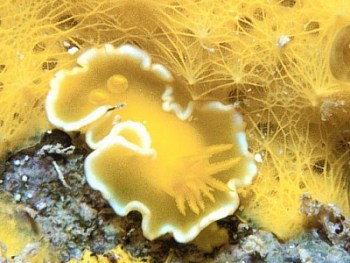
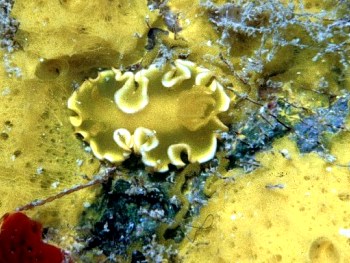
Hi Bill,
Here's an addition to your Noumea crocea page. Both shots show the animal on its apparently exclusive food sponge, and in the lower shot, it is on its egg mass as well. This species was not uncommon at Enewetak Atoll in the Marshall Islands, but seems to be quite rare here at Kwajalein, about 350 miles southeast of Enewetak, where I have found only a single individual. I also have records from Nauru Island and from the Solomons.
Scott
johnson@kmr.ll.mit.edu
Johnson, S., 2001 (Jun 15) Noumea crocea - food and spawn. [Message in] Sea Slug Forum. Australian Museum, Sydney. Available from http://www.seaslugforum.net/find/4599Thanks Scott,
Bill Rudman
Re: Noumea crocea from Papua New Guinea
May 23, 2000
From: Stuart Hutchison
Dear Bill,
Melinda found the Noumea crocea on 15 May 2000. Coincidentally, it was about two feet away from the other tiny yellow nudi that I sent you (the one with the red mantle margin) [Noumea flava].
Regards,
Stuart
hutchco@tpg.com.au
Hutchison, S., 2000 (May 23) Re: Noumea crocea from Papua New Guinea. [Message in] Sea Slug Forum. Australian Museum, Sydney. Available from http://www.seaslugforum.net/find/2429Thanks Stuart,
Basic date, depth, and locality data give a photographic record like this considerable credibility for anyone studying the geographic distribution of a species. The date may not seem important but if a species turns out to be an introduction from another region such records become extremely valuable in documenting the invasion.
Best wishes,
Bill Rudman.
Noumea crocea from Papua New Guinea
May 21, 2000
From: Stuart Hutchison
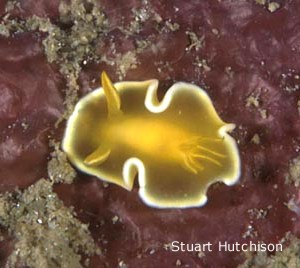
Dear Bill,
found this one at 12m on a steel wreck at Lion Island, Papua New Guinea. The animal was about six millimeters long. Do you know what it's called?
Stuart Hutchison
hutchco@tpg.com.au
Hutchison, S., 2000 (May 21) Noumea crocea from Papua New Guinea. [Message in] Sea Slug Forum. Australian Museum, Sydney. Available from http://www.seaslugforum.net/find/2393Dear Stuart,
It's Noumea crocea, a yellow chromodorid for which we have few records, so yours is quite welcome.
If you can give me some idea of a date for any of your photos it would make the observation valuable for future research records.
Best wishes,
Bill Rudman.
Noumea crocea from Philippines
April 21, 1999
From: Erwin Koehler
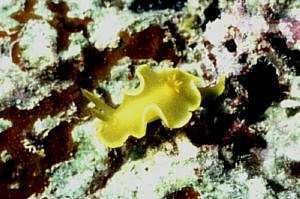
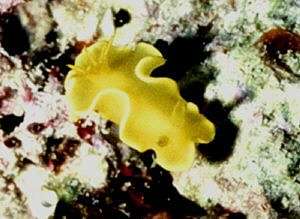
Bill,
These photos are by my buddy Klaus Stark - email:K.Stark@t-online.de
They were taken at:
Philippines, Cebu Is., Ronda Bay Sanctuary, 9m depth, March 1999, size 24mm.
Thanks,
Erwin
Medslugs.Koehler@t-online
Koehler, E., 1999 (Apr 21) Noumea crocea from Philippines. [Message in] Sea Slug Forum. Australian Museum, Sydney. Available from http://www.seaslugforum.net/find/793Dear Erwin,
This is Noumea crocea. I think this is the first record from the Philippines.
Bill Rudman.
Re: Possible Glossodoris
March 30, 1998
From: Lindsay Warren
Dear Bill
Many thanks for coming back to me so quickly about the possible Noumea. I didn't include details then as I wasn't sure if the definition was adequate. Unfortunately I did not find this one and at the time we weren't keeping precise notes as the surface on which it was found. However, I do know that it was found between 0-60 ft of water on a leeward wall of Pulau Hoga, a very small island next to Pulau Kaledupa in the Tukang Besi islands, SE Sulawesi.
The wall is heavily covered in both hard and soft corals as opposed to a sandy or rubbly bottom. The body was entirely translucent yellow with white edges to the mantle which would 'ripple' as it moved - a muscular induced movement rather than caused by motion through the water. Length - approx 2.5 cms.
Many thanks
Lindsay Warren
100014.2112@compuserve.com
Warren, L., 1998 (Mar 30) Re: Possible Glossodoris. [Message in] Sea Slug Forum. Australian Museum, Sydney. Available from http://www.seaslugforum.net/find/86Possible Glossodoris
March 28, 1998
From: Lindsay Warren & Kevin Reed
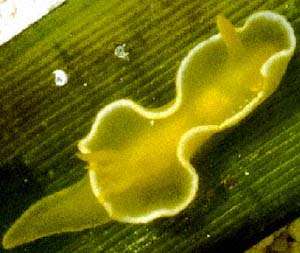
Dear Bill
For the past two years we have taken part in Operation Wallacea based on Pulau Hoga part of the Tukangbesi archipelago, SE Sulawesi, Indonesia. Most of the work has revolved around habitat mapping as well as swim surveys of chaetodons and commercial fish. Last September, due to technical problems a fair part of our four weeks were based on Hoga and since it had been well surveyed on the other two aspects, we were able to turn our attention to other species. During our four week stay, some of the dives were directed towards nudibranchs and we photographed at least 60 different species. Unfortunately some of these we have not been able to identify. Bernard Picton who was out there with us suggested that we email these to you.
I have attached one for the moment - a possible glossodoris to see if this format is sufficient. Unfortunately this shot (all prints) was not the sharpest one would want but I thought you might be able to shed some light on it. If this format is ok, I will email the others to you for your comments. Eventually I hope to get a negative scanner to improve quality.
I think your forum is a brilliant idea and look forward to checking it out on a regular basis now that I know of its existence.
Many thanks for your help
All the best
Lindsay Warren & Kevin Reed
100014.2112@compuserve.com
Warren, L. & K. Reed, 1998 (Mar 28) Possible Glossodoris. [Message in] Sea Slug Forum. Australian Museum, Sydney. Available from http://www.seaslugforum.net/find/87It certainly looks like a species of Glossodoris with the mantle tucked in at each side to form a "waist". However there are species of Noumea and Thorunna that do that as well. I think your animal is Noumea crocea, one of a group of yellow chromodorids I reviewed in 1986 (see pub. 46 in my publications list). To be absolutely sure you would need to look at the reproductive system and the radula.. Bill Rudman.
Rudman, W.B., 1998 (Mar 28). Comment on Possible Glossodoris by Lindsay Warren & Kevin Reed. [Message in] Sea Slug Forum. Australian Museum, Sydney. Available from http://www.seaslugforum.net/find/87